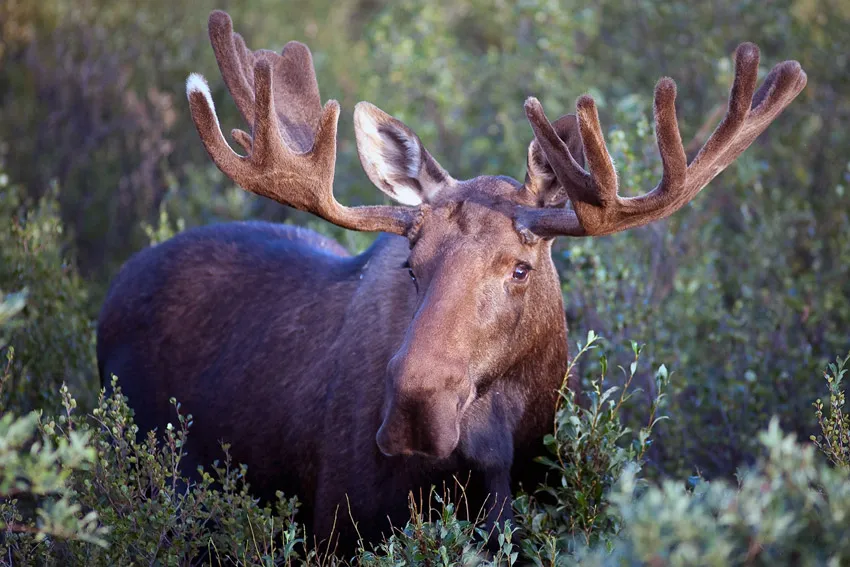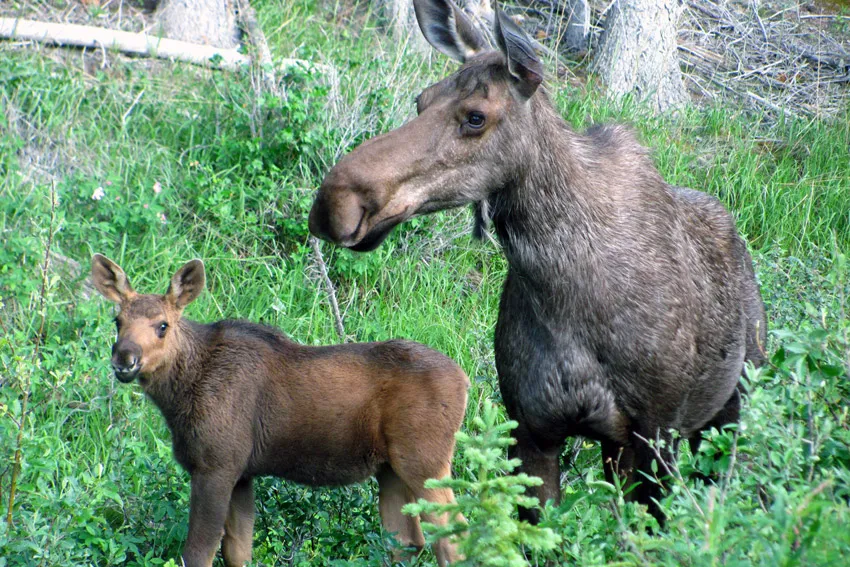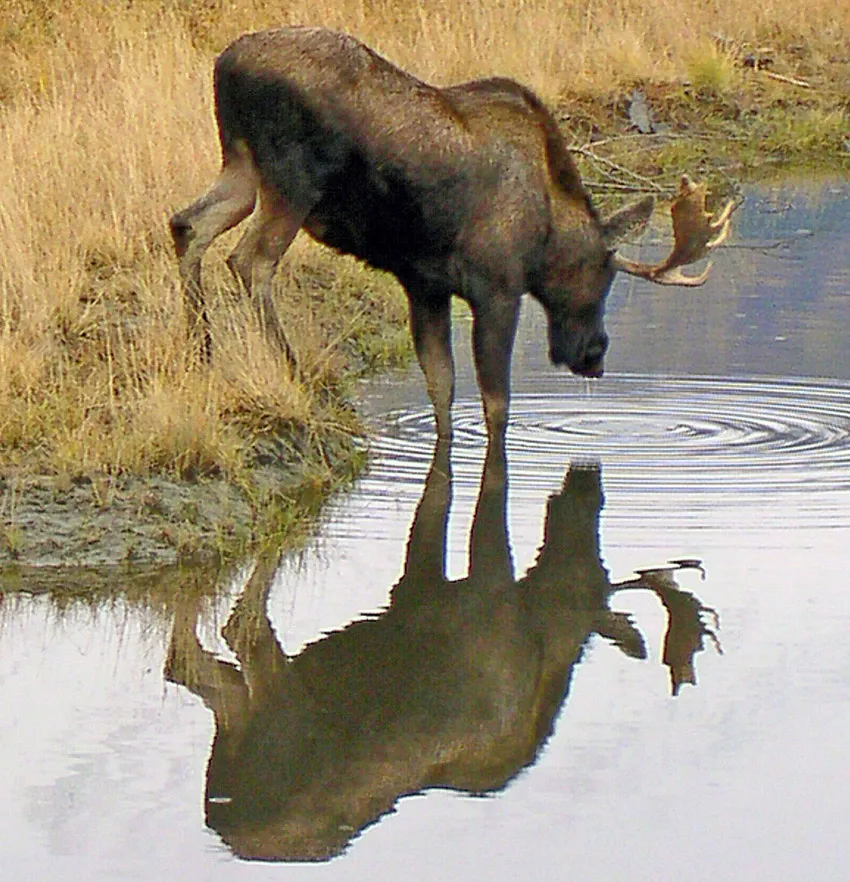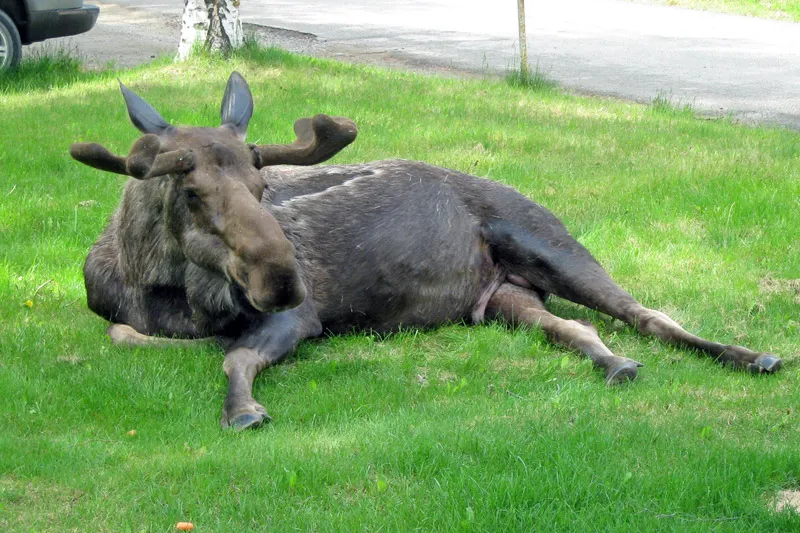Moose / Elk - Facts and Adaptations
Alces alces
The largest of the deer species, known as the Moose in North America and Elk in Eurasia, there is some debate as to whether these are one or two species, though more usually it is considered that there is a single species with 8 sub species.
Moose / Elk facts Basics
Average Weight: Males - 380-700 kg (840-1540
lbs). Females 200-490 kg (440-1080 lbs).
Average Length: 2.4-3.1m (7.9-10.2ft) head and
body, the tail is very short adding only 5-10 cm.
Average height at shoulder: 1.5-2.1m
(5-6.5 ft), can reach over 2.1m (6.9 ft).
Antlers: Only the males have antlers, a
mature bull has antlers that are typically 1.2 - 2 m wide
(3.9-6.1 ft), they are described as being palmate with a
flattened region.
Breeding Season:
September to October when the males bellow to attract mates
and warn off other bulls, the antlers are used to attract
mates and repel rivals alike, they are shed shortly after
the mating season. After mating the two sexes go their separate
ways and the females give birth to one or two calves the
following spring. Calves are around 14 kg (30 lbs) at birth,
they stay with their mother until the mating season, like
many herbivores they are quite well developed when born
and will be able to outrun a human at 5 days old.
Estimated world population: - There
are thought to be about a million moose in North America
and 1.3 million across Eurasia, European populations in
particular have increased dramatically in the last 50 years,
numbers are increasing almost every where they are found.
The highest population density is found in Sweden.
Feeding & diet: Herbivorous, in
the summer they will browse on high grasses, shrubs, and
trees, it is easier for them to reach upwards than to lower
their heads to ground level. In the winter they use their
hooves to clear snow away and browse on mosses and lichens,
at the end of winter before the land plants have grown much
they will often enter water to browse on aquatic plants,
both floating and submerged, they may even dive down to
reach plants on lake bottoms. They are not grazing animals,
but browsers who are much more selective about which plants
and which parts of plants they eat, they have a varied and
complex diet which is difficult to provide, a reason that
moose have never been widely domesticated.
Conservation status: Least Concern.
Distribution: Moose and Elk are found
in woodland habitats from the northern tree line southwards
where their range is limited by too warm summer temperatures,
they range up to about 2500m altitude. They prefer terrain
that is a mixture of woodland with openings and bodies of
water such as lakes, swamps and wetlands. Their populations
are generally declining in the temperate regions of their
zone and rising in the Arctic and sub-Arctic.
Predators: Siberian tiger, grey wolf (packs),
brown bears, black bears, Orcas (moose sometimes swim between
islands) wolverine. Adult moose, especially the bulls are
large and formidable as prey, most predators choose to hunt
the smaller females, especially if they are with a calf
or are weak or ill, even a small moose represents a substantial
kill. Moose and Elk are extensively harvested for food by
humans, in Europe about half of a population of nearly 5000,000
are harvested annually, even so, the population is growing.
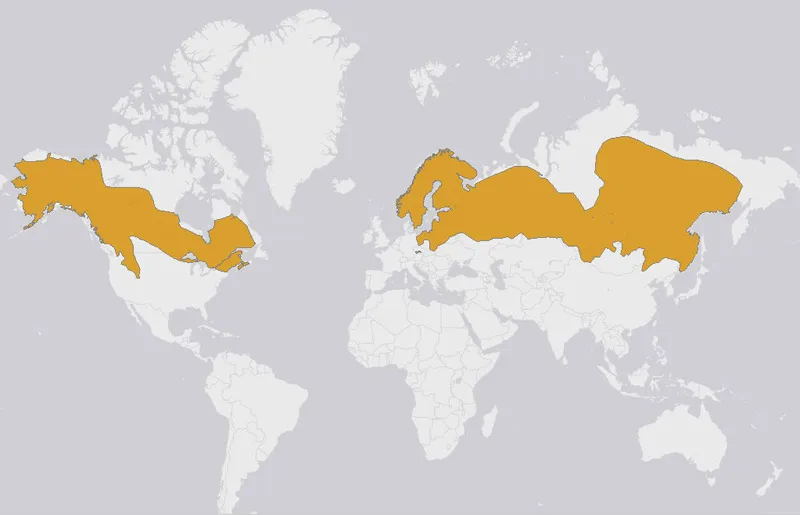
Distribution range
of Alces alces - Moose and Elk
What are Moose like? how do they survive?
Moose are very large animals, they are the largest of the species of deer, the males are immediately identifiable by their huge antlers, they have very long faces with a muzzle that hangs over the mouth and chin. They are unusual amongst deer species in that they are solitary rather than living in herds, they are generally slow moving sedentary animals though can be aggressive if startled or angered in which case getting out of their way is usually enough.
There are eight sub-species of moose, and a number of alternative names some of which apply to a particular sub-species, though not necessarily. They may be known as Moose, Elk, Eurasian Moose, Eurasian Elk or Siberian Elk. They all belong to the species Alces alces, The commonest European subspecies is Alces alces alces, the eastern North American subspecies is Alces alces americana, and the largest of all, the Alaskan and Yukon Moose id Alces alces gigas. They have a number of anatomical, behavioural and physiological adaptations that allow them to survive successfully in their environment.

Bull moose feeding
on aquatic plants, note the soft velvet on the still growing
antlers
Moose Adaptations:
- Males (called bulls) have large antlers
(anatomical) - This a deer adaptation rather than being
anything to do with a cold climate. The males grow their
antlers from scratch every year starting in the spring.
Antlers are made of bone, as they grow they are nourished
by a kind of skin covering them entirely called velvet,
the soft brown covering you often see in pictures, this
means the antlers are not full size and are still growing.
Eventually when the antlers are their full final size, the
velvet dries up and is shed. The antlers are used to display
to other males to assert dominance and also to females who
are potential mates, mostly by sizing up from a distance,
there is no point in a male engaging in physical combat
with another male who is clearly bigger and stronger, only
when two well matched males meet and when neither will back
down to they come to blows and lock antlers. After the mating
season the antlers are shed so as not encumber the moose
with their weight or tendency to unbalance the head. Being
able to grow such large structures which can weigh 20-30
kg every year is a good sign of an animal that is in excellent
physical shape and so is a good indicator to other males
and females alike.
- Very sensitive snout with tough lips and tongue
and a prehensile (capable of grasping) upper lip
(anatomical / physiological) - Moose are browsers rather
than grazers. They don't just eat grass like an animal
lawnmower such as a cow, they are more selective about the
kind of food they eat which is necessary in an environment
where nutrient rich vegetation is not so common. Their lips
enable them to pull off the more nutritious growing tips
of trees while avoiding the woody twigs that are far less
nutritious and far more difficult to digest as well. Their
environment is one where there is plenty of available plant
food (hence all the moose around) but it needs expert equipment
to get enough of the right stuff.
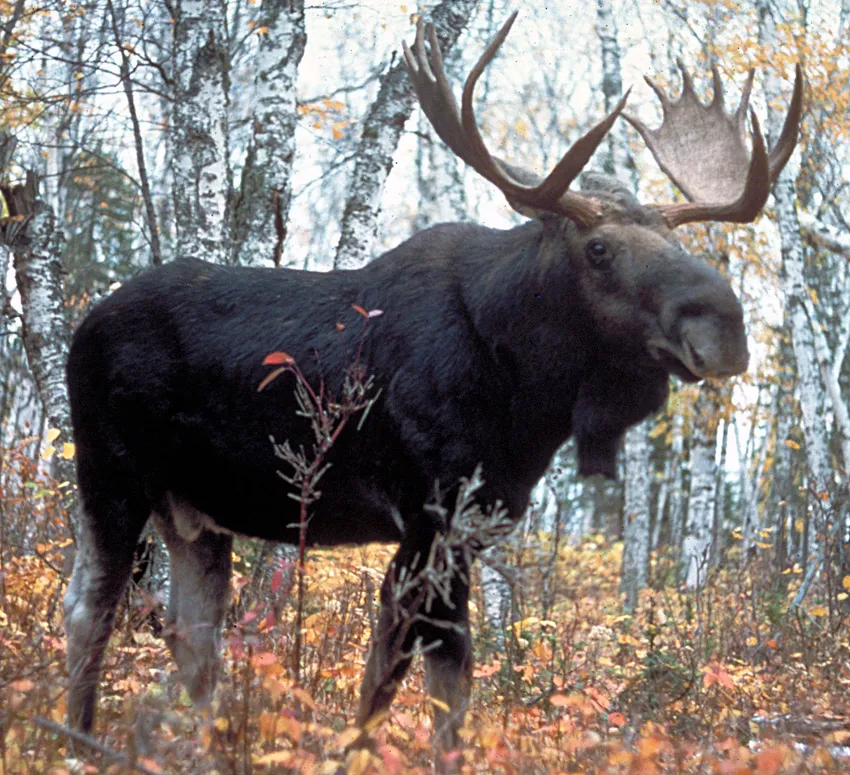
Bull moose with fully
developed antlers that have lost their velvet
- Long legs and wide hooves (anatomical)
- Moose legs are long, they are also able to rotate sideways
in ways that horses for instance cannot, this enables them
to have a long reach, they can kick out with front or back
legs in any direction against predators. An unwary wolf
when hunting moose can readily end up a dead wolf with a
well aimed kick, there is no safe direction to approach
an unhappy moose from. Their long legs enable them to handle
deep snow up to nearly a meter if they need to though they
will usually take shelter in woodland if the snow is very
deep outside. Their hooves can spread to distribute their
weight more widely on snow or muddy / marshy ground - like
snow shoes, they are also of great use in the winter when
clearing the ground of snow to get to food such as mosses
and lichens under the snow.
- Good swimmers quite at home in water
(behavioural) - Moose will swim up to several km between
islands, they are often seen in bodies of water especially
when the ice breaks up or melts feeding on the newly available
aquatic plants before the land plants have started to grow
very much in the spring.
- Solitary animals outside the breeding season
(behavioural) - This may be related to their feeding habits
where they eat a variety of food that is widespread over
a large area though not concentrated enough to support herds.
- A rich fur coat for retention of heat and protection
from the weather (anatomical) -
There is a soft fine undercoat of woolly insulating
hairs and a longer coarser top coat of protective guard
hairs. The longer guard hairs help to shed rain and the
worst of the weather. The coat as a whole also traps air
when in water which helps make the moose buoyant and so
more able to be able to swim well. A thicker undercoat is
grown for the winter which is then shed the next spring/summer.
- Very keen sense of smell (anatomical/physiological)
- To help the moose to find food beneath the the snow, knowing
where to dig.
- Large animal with low surface area to volume ratio (anatomical) - Large animals retain their temperature and warm up more easily than smaller animals, it's not a surprise that a large animal like a moose should live in a cold place, being large helps it in this regard.
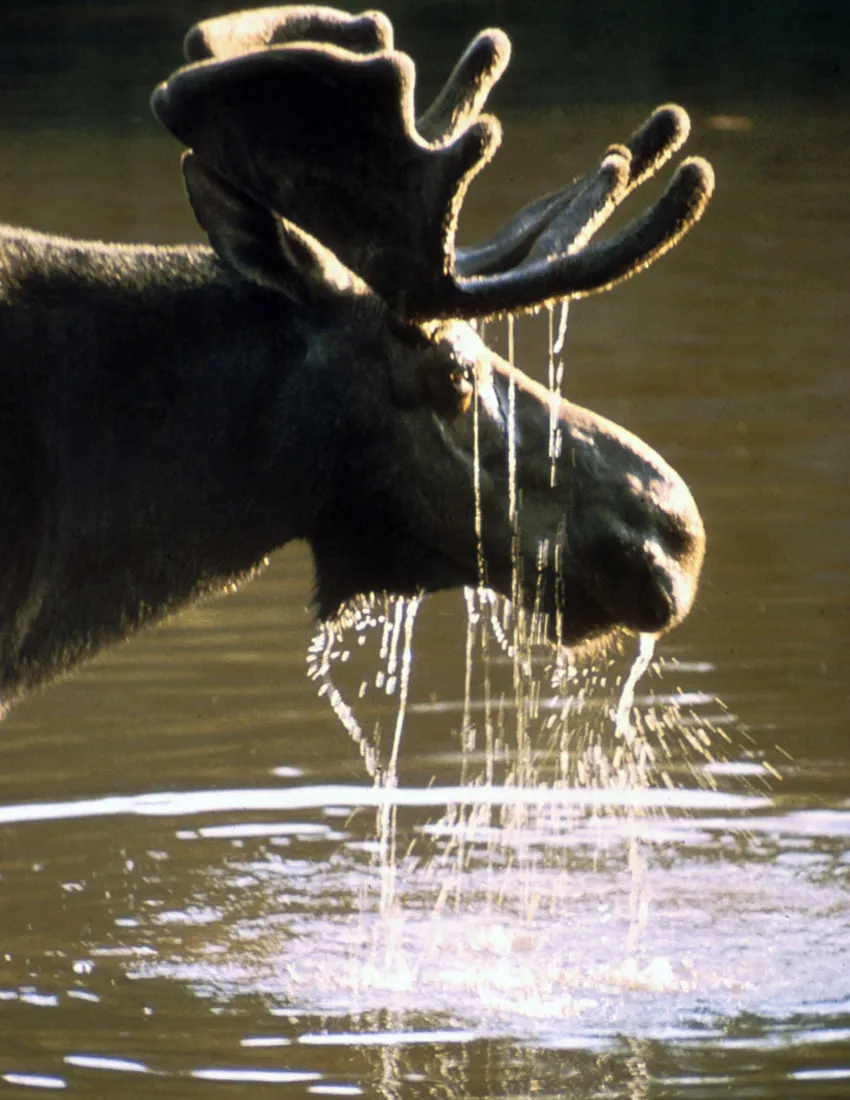
Moose with developing antlers
Creative Commons Attribution 2.0 license - Top picture, Bull Moose - Denali National Park and Preserve
Creative Commons Attribution 3.0 license - Moose mother with calf - Veronika Ronkos

